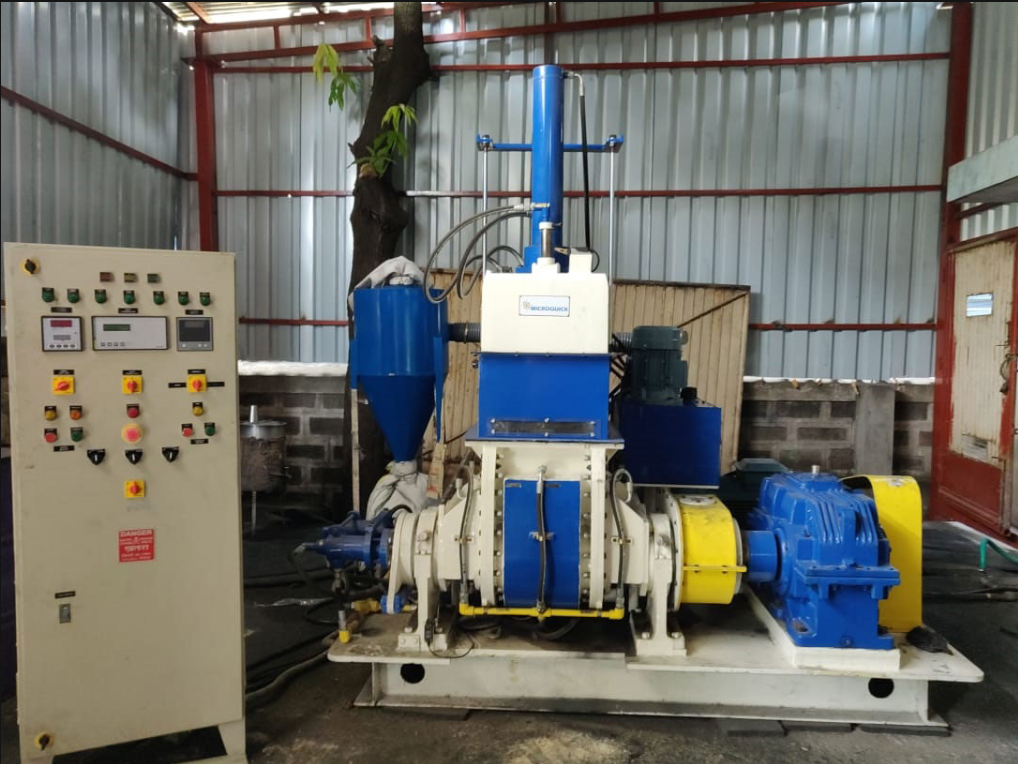Introduction
Rubber mixing equipment plays a crucial role in numerous industries, ranging from automotive to consumer products. As an essential part of the production process, it ensures high-quality rubber products by effectively combining various ingredients and polymers. Understanding the significance of rubber mixing and selecting the right equipment can lead to enhanced performance, consistent quality, and improved production efficiency.
Objectives of Rubber Compounding
Rubber compounding is an essential process in the production of high-quality rubber products. It involves the careful selection and blending of various ingredients, such as polymers, fillers, and additives, to achieve the desired properties in the final product. The main objectives of rubber compounding include:
Achieving desired properties in the final product
Each rubber product has specific requirements in terms of physical and mechanical properties, such as tensile strength, elongation, hardness, and resistance to various environmental factors. Rubber compounding plays a crucial role in tailoring these properties to meet the needs of the end-user application. By choosing the right combination of polymers and compounding ingredients, manufacturers can create a rubber compound with the desired characteristics.
Consistency in quality and performance
To ensure that rubber products perform consistently over time and across different production batches, it is essential to maintain a high level of quality and performance in the rubber compounds used. This is achieved through the careful control of the compounding process, including the selection of raw materials, mixing parameters, and quality control measures. By maintaining consistency in the rubber compounding process, manufacturers can guarantee that their products will deliver the expected performance in various applications.
Improving production efficiency
Another important objective of rubber compounding is to improve production efficiency, which can directly impact the profitability and competitiveness of a rubber manufacturer. By optimizing the compounding process, manufacturers can minimize waste, reduce production time, and increase throughput. This can be achieved through the use of advanced rubber mixing equipment, such as hydraulic dispersion kneaders, which offer better control over the mixing process and ensure a more efficient and consistent production of rubber compounds.
Key Components of Rubber Mixing Equipment
The rubber mixing process is an essential part of producing high-quality rubber products. Various types of rubber mixing equipment are used to achieve the desired results. Each equipment has a specific function and contributes to the overall efficiency and effectiveness of the mixing process. Let’s take a closer look at the key components of rubber mixing equipment:
Internal Rubber Mixers
Internal rubber mixers are widely used in the rubber industry due to their ability to provide consistent mixing and excellent dispersion of ingredients. These mixers consist of a closed mixing chamber with rotors that help mix the rubber compound effectively. The rotors create high shear and compression forces, promoting efficient mixing and dispersion of the ingredients within the compound.
Hydraulic Dispersion Kneaders
Hydraulic dispersion kneaders, such as those offered by Microquick Engineers, are designed to provide automated continuous hydraulic compression on ingredients, resulting in excellent dispersion and consistent quality compounding. Their innovative design ensures a short batch preparation time of 7-12 minutes, allowing for faster production and reduced energy consumption. Hydraulic dispersion kneaders are well-suited for various industries, including automotive, industrial, consumer products, healthcare, and electrical sectors.
Twin Screw Sheeters
Twin screw sheeters are another essential component of rubber mixing equipment. They provide a continuous sheeting process for the rubber compound, ensuring a smooth and homogeneous output. This equipment is particularly beneficial for reducing air entrapment and ensuring consistent thickness throughout the sheet, ultimately improving product quality and performance.
Mixing Mills
Mixing mills are used to mix, refine, and homogenize rubber compounds. They consist of two large, counter-rotating rolls that apply pressure and shear forces to the rubber compound. Mixing mills are versatile and can be used for various applications, including mixing, warming, sheeting, and cooling the rubber compound. They are a vital part of the rubber mixing process and contribute significantly to the quality and performance of the final product.
In conclusion, the key components of rubber mixing equipment play a crucial role in ensuring high-quality and consistent rubber products. By understanding the functions and benefits of these components, manufacturers can select the appropriate equipment and optimize their rubber mixing processes for improved efficiency and performance.
Principles of Mixing in Rubber Mixer
Understanding the principles of mixing in a rubber mixer is crucial for achieving optimal results in terms of quality and performance. There are three key aspects to consider when it comes to rubber mixing:
Efficient Dispersion of Ingredients
An important principle in rubber mixing is the efficient dispersion of ingredients, which ensures that all components of the rubber compound are evenly distributed throughout the mixture. This helps in achieving a consistent product with uniform properties, as well as minimizing the occurrence of defects and variations in the final rubber product. To achieve efficient dispersion, it is essential to select the appropriate rubber mixing equipment and optimize the mixing parameters, such as mixing time, temperature, and rotor speed.
Homogeneous Blending of Polymers
Another essential aspect of rubber mixing is the homogeneous blending of polymers. This involves combining different types of polymers and additives in a uniform and consistent manner, which is critical for achieving the desired properties and performance characteristics in the final rubber product. A good quality rubber mixer should be capable of blending polymers effectively and consistently, ensuring that the resulting compound exhibits the intended properties and performance characteristics.
Control of Temperature during the Mixing Process
Controlling the temperature during the mixing process is a vital principle in rubber mixing. Maintaining an appropriate temperature throughout the mixing process helps prevent premature curing or scorching of the rubber compound, which can lead to defects and poor-quality products. It also aids in the efficient dispersion of ingredients and the proper blending of polymers, resulting in a high-quality rubber compound. To achieve optimal temperature control, it is essential to use rubber mixing equipment with advanced temperature monitoring and control features, as well as to carefully manage the mixing process parameters.
In conclusion, adhering to these principles of mixing in a rubber mixer is essential for maximizing quality and performance in rubber mixing equipment. By focusing on efficient dispersion of ingredients, homogeneous blending of polymers, and temperature control during the mixing process, manufacturers can ensure that their rubber compounds are of the highest quality and meet the desired performance standards.
Factors to Consider for Maximizing Quality and Performance
To achieve optimal results with rubber mixing equipment, it’s crucial to consider several key factors that can impact both the quality and performance of the final product. These factors encompass selecting the right mixing equipment, optimizing mixing parameters, and maintaining the equipment properly.
Selection of Appropriate Rubber Mixing Equipment
Choosing the right rubber mixing equipment is essential for maximizing quality and performance. This involves:
- Considering production capacity and batch size: Selecting a rubber mixer that aligns with your production requirements and batch size ensures efficient processing and optimal results. An undersized or oversized mixer can lead to inconsistencies, longer mixing times, and increased wear on equipment components.
- Suitability for specific rubber compound formulations: Different rubber compounds may require specific mixing equipment or settings to achieve the desired dispersion and homogeneity. Ensure the rubber mixer you select is compatible with the specific formulations you will be processing.
Optimization of Mixing Parameters
Optimizing the mixing process is vital for achieving the best quality and performance. Key parameters to consider include:
- Mixing time: Adequate mixing time ensures proper dispersion of ingredients and a homogeneous final product. However, over-mixing can cause excessive heat generation and degrade the rubber compound.
- Mixing temperature: Controlling the temperature during the mixing process is crucial to prevent compound degradation and ensure a consistent product. Monitor and adjust the temperature as needed to maintain optimal processing conditions.
- Rotor speed: The speed of the mixer’s rotors affects the rate of ingredient dispersion and the overall mixing efficiency. Finding the appropriate rotor speed for your specific rubber compound formulation can improve product quality and consistency.
Proper Maintenance and Care of Mixing Equipment
Maintaining the rubber mixing equipment is critical for ensuring its continued performance and longevity. Key maintenance practices include:
- Regular cleaning and inspection: Keep the mixing equipment clean and inspect it regularly for signs of wear or damage. This helps identify potential issues before they become more significant problems.
- Timely replacement of worn-out parts: Replace worn or damaged components promptly to maintain optimal equipment performance and prevent potential failures.
- Lubrication of moving parts: Properly lubricate all moving parts to reduce friction, wear, and potential equipment failure. Follow the manufacturer’s recommendations for lubrication type, frequency, and quantity.
Advances in Rubber Mixing Technology
In recent years, the rubber mixing industry has witnessed significant technological advancements aimed at improving efficiency and quality. These innovations have led to the development of new mixing equipment and techniques that enhance the overall performance and energy consumption of rubber mixing processes.
Recent Developments for Improving Mixing Efficiency
One of the main objectives of rubber mixing technology is to increase efficiency and reduce the time required for mixing. To achieve this, researchers and engineers have introduced various improvements, such as the use of more powerful motors, optimized rotor designs, and advanced control systems. These enhancements not only reduce the overall mixing time but also ensure better dispersion of ingredients and homogeneity in the final product.
Tandem Technology in Rubber Mixing
Tandem technology has emerged as a promising solution to further improve rubber mixing efficiency. This approach involves the use of two or more mixers connected in series, allowing for continuous mixing and reduced batch preparation time. Tandem technology enables better control over the process, resulting in consistent quality and reduced chances of human error. Additionally, it provides a more streamlined production process, leading to lower labor costs and increased productivity.
Energy-Efficient Mixing Equipment
As energy costs continue to rise, the need for energy-efficient mixing equipment has become increasingly important in the rubber industry. To address this issue, manufacturers have developed mixers with enhanced insulation, lower friction, and optimized motor efficiency. These features not only reduce energy consumption but also contribute to the overall sustainability of rubber production processes. By investing in energy-efficient mixing equipment, manufacturers can benefit from both cost savings and an improved environmental footprint.
In conclusion, the ongoing advancements in rubber mixing technology are driving significant improvements in efficiency, quality, and sustainability. By staying informed about these innovations and incorporating them into their operations, manufacturers can ensure the highest quality products while minimizing costs and environmental impact.
Microquick Engineers’ Hydraulic Dispersion Kneaders
Microquick Engineers, a leading manufacturer and exporter, offers high-quality Hydraulic Dispersion Kneaders designed to maximize quality and performance in rubber mixing. These kneaders come with a range of features and benefits, catering to various industries and boasting unique selling points that set them apart from other rubber mixing equipment in the market.
Features and Benefits
The Hydraulic Dispersion Kneaders from Microquick Engineers boast numerous features and benefits, contributing to efficient and consistent rubber mixing. One of the primary features is the automated continuous hydraulic compression on ingredients, ensuring precise control over the mixing process. This results in excellent dispersion of ingredients within the rubber compound and consistent quality compounding, leading to a higher quality final product. Additionally, these kneaders are designed for low energy consumption, making them an environmentally friendly and cost-effective choice for rubber mixing applications.
Applications in Various Industries
Microquick Engineers’ Hydraulic Dispersion Kneaders are versatile and adaptable to various industries, including:
- Automotive
- Industrial
- Consumer products
- Healthcare
- Electrical
Across these industries, the kneaders play a crucial role in producing high-quality rubber products, ensuring consistent quality and performance.
Unique Selling Points
Microquick Engineers’ Hydraulic Dispersion Kneaders stand out in the market with their unique selling points. Faster production is a significant advantage, as the kneaders have a batch preparation time of just 7-12 minutes. The operator-friendly design makes it easy to use and maintain, while the compact size allows for easy installation and integration into existing production lines. These features make Microquick Engineers’ kneaders an excellent investment for businesses looking to improve their rubber mixing processes and produce high-quality products consistently.
Conclusion
In conclusion, maximizing quality and performance in rubber mixing equipment is of paramount importance, as it directly impacts the final product’s properties and consistency. By considering key factors such as the appropriate selection of rubber mixing equipment, optimization of mixing parameters, and proper maintenance and care of the equipment, optimal results can be achieved.
Microquick Engineers, as a leading manufacturer and exporter of Hydraulic Dispersion Kneaders, is committed to providing high-quality and efficient rubber mixing equipment. Their products not only deliver excellent dispersion of ingredients and consistent quality compounding but also offer energy-efficient and operator-friendly solutions to cater to the diverse needs of various industries.
By following the insights and recommendations shared in this article, manufacturers can ensure that they are making the most of their rubber mixing equipment, ultimately leading to improved product quality, performance, and overall efficiency in the rubber compounding process.
Discover More Opportunities
Maximizing quality and performance with rubber mixing equipment is essential for achieving desired properties and consistency in rubber products. Microquick Engineers, a leading manufacturer and exporter of Hydraulic Dispersion Kneaders, offers innovative solutions for your rubber compounding needs. Their products ensure excellent dispersion, consistent quality, and faster production, making them a valuable investment for various industries, including automotive, industrial applications, consumer products, healthcare, and electrical sectors.
Explore the full potential of Microquick Engineers’ Hydraulic Dispersion Kneaders and other offerings by visiting their product page . For detailed technical features and specifications, download the brochure . If you need expert advice on choosing the right rubber mixing equipment for your needs, do not hesitate to contact Microquick Engineers .


